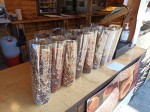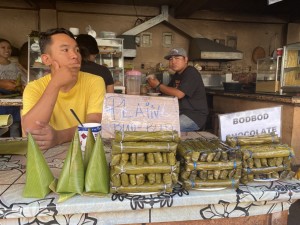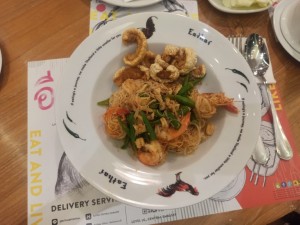EAT IN ASIA / Destinations / Other destinations / Europe / Romania
Sweets in Romania’s cuisine
Tags: ROMANIA









Almost everybody loves sweets. Different countries, different cultures and different ingredients, but one thing is common for almost the whole world – love of sweets. This love is also reflected in the local cuisine, that can be influenced by many factors. Depending on the location and the territory, Romanian desserts have multinational influences. Especially visible are those from Turkey, Hungary, Germany, and Austria. Apart from that, Slavic, Latin and Balkan motives and culture elements influenced local Romanian cuisine. However, different territory regions across the country have their own, the most significant foreign influences. For example, Transylvania combines mainly German and Turkish elements, while Moldova has a lot of Slavic and Turkish influences. Then you have for example Muntenia, that is hugely influenced by Latin and Balkan culture.
Romanian sweets are different in their textures, flavors, and forms. Starting with mild and delicate, through crunchy, with crusts and finally finishing on foamy or creamy. Deserts might be extremely sweet, or bitter, or sour or even salty! Both soft and hard, without baking, deep-fried or baked. Almost every way of preparing a dessert, that might come to your mind, will be there. You will find a number of examples of them in the Romanian cuisine. Actually, the most popular are these sweet, with honey, chocolate, nuts, apples and cheese.
Let’s start our culinary trip through some most popular and significant Romanian sweets!
Romanian Cheese Doughnuts – Papanasi

Papanasi is a Romanian dessert that you would probably find in every place in the country. Every restaurant, every motel or the smallest local bar will probably have it, even if their dessert menu is a short one.
However, depending on the region, papanasi is prepared in a different way. In some regions like Transylvania, papanasi is boiled, while in Moldova, for example, it is fried. And what exactly is papanasi? Papanasi is a donut-like dessert that is filled with a delicate cottage cheese, cream and a fruity sauce on top. The dough for papanasi is mainly made of a soft white cheese, flour, eggs, and sugar. Finally, it is topped with sour cream and usually dark fruits. The fruity sauce might be either a berry one or it can be replaced by a forest fruit jam.
The dessert is sweet, relatively heavy, and fatty, especially in case of a fried papanasi version. Papanasi is served as a single, one donut, or in a set of two smaller donuts. It is usually warm and freshly made, so you might have to wait a couple of minutes.
Pancakes - Crepes

Sweet pancakes are well known probably by everyone. Quite easy to prepare, tasty and with a plethora of different filling possibilities. North and South America, Asia, Africa, Australia, and Europe – all continents and countries love it. And almost all countries have their own version of pancakes, but still, the base recipe stays the same. The difference might be in the used flour, milk, and filling ingredients; however, the base is the same. Panacakes should be fluffy, thin, and well fried on an almost fatless pan. When preparing traditional, French style crepes, a big, it would be good to use a flat special pan. Thanks to that, crepes that you would prepare would be very thin, homogenous, and regularly fried. The special crepes frying board will allow you to make them without almost any oil or butter.
Pancakes come in a different size and shape. Sometimes they are folded into triangles, sometimes into long rolls and sometimes in a pocket like shape and size.
Hungarian and Romanian pancakes vary in the same way from place to place and from the restaurant to another. Include to it local bars, homes, and small gastronomic points, and you will get hundreds of possibilities and variations.
The favorite filling is the chocolate one. However, soft, fresh white, cottage cheese, nutella, bananas, fruits and nuts are also very popular. Add to it double or triple combinations of them and then you will get a huge choice once again. Pancakes are finally topped with cream, sour cream, and some sweet sauce. Usually, a chocolate or a toffee one is used, especially that it also creates a nice visual composition. Another good option is to add a scoop of vanilla ice cream to that and sprinkle them with finely grounded sugar powder or with small and colorful tiny candies.
Pancakes are served warm, even if they are served with ice creams aside.
Chimney cake - Kürtőskalács

Kürtőskalács is another Hungarian and Romanian stapple dessert. It is also known under the name of a chimney cake, as its shape reminds house chimneys. Kürtőskalács are tall – about 30 to 40 cm high, have a diameter of about 1 to 12 cm and are empty inside. So, let’s say, it is a dough roll without any inside filling. The only decoration and any extra flavor are added around the cake. Kürtőskalács can be sprinkled with nuts, cinnamon, sugar, coconut flakes, and with colorful candies. Usually, chimney cakes have a mix of them. Apart from that, some kürtőskalács are sunk in a slightly heated, warm milk chocolate just after being baked, but the traditional one comes with cinnamon and sugar only. Chimney cakes have a long history and were often offered for weddings, special events and celebrations. Nowadays, they are even more popular, and thanks to the easiness of making them in a stand-alone bar, they became extremely popular and liked in most touristic spots. If you wish to know more about what to eat in a touristic place in Romania, read the post!
Homemade chocolate

Romanian homemade chocolate is something you really have to try! First of all, because it is something unique and secondly, because it is homemade and local.
The dessert has its roots in the communist era, when a lot of Western products and delices were not available in stores. In consequence, local people tried in different ways to find a substitute of it and started making chocolate at home. Ingredients were very simple, and the recipe has not changed since that time. Mainly, what you would need, is powdered milk, butter, sugar, and cocoa. After combining all ingredients and heating it a little bit, you will get a delicate mass, which should be formed in a block. Finally, after cooling it down, you will get chocolate that is delicate, creamy and although not the same or not an ideal chocolate replica, but with its unique taste and made at home. Try chocolate bars sold on local food stalls, as they are these that follow old grandmother’s recipes!
Chocolate biscuits

When talking about chocolate desserts, one cannot forget about another extremely popular Romanian dessert – chocolate salami or chocolate biscuits. As in the case of a homemade chocolate, also this one derives from the communist period, when it became extremely popular. Although the history of it is longer, never till that time was it so popular.
Ingredients are almost the same as for the homemade chocolate. So, milk, cocoa, butter, and sugar create the base. Finally, are added crushed biscuits, and in some recipes also raisins that were soaked in rum. The preparation process is also similar to the one of the chocolate. All ingredients are mixed, slightly warmed and then formed in a preferred shape. Depending on whether you would like to get a chocolate salami or a chocolate bar, form it in such a way. Then put it to the fridge for a couple of hours and let it rest and get a solid form.
In a traditional form it was rolled into a salami shape and then cut into slices just before serving. Crushed, pale biscuits from inside make it really look like a salami sausage!
This easy and quick to prepare cake with no baking is a great option for all surprised by unexpected guests.
Ice-cream desserts

Finally, the list could not be complete without ice-creams. Ice desserts, with whipped cream, fresh fruits or fruity sauces with full fruits, are something that you cannot skip in warm days. Add to that local fruits like plums, pears, forest berries and cherries and let it cool you down during Summer days! If you want to know more about desserts in other countries and about home-made ice-creams too! Finally, do not forget to check our post about TOP Hungarian and Romanian local food!
Date: 2021-12-06
Author: Beti – A passionate traveler and lover of Asian cuisine, especially Thai and Japanese dishes, Bernadeta brings her culinary and cultural experiences to life in her writing. Beyond her travels, she’s an avid technology enthusiast with a deep interest in data processing, merging her love for exploration with analytical insights.
Photographer: Adalbert – An aficionado of computers and photography, Adalbert captures the essence of diverse cuisines with a discerning eye. A connoisseur of rich flavors and particularly fond of meat-based dishes, he combines his technical skills with his passion for the culinary arts in every shot.









